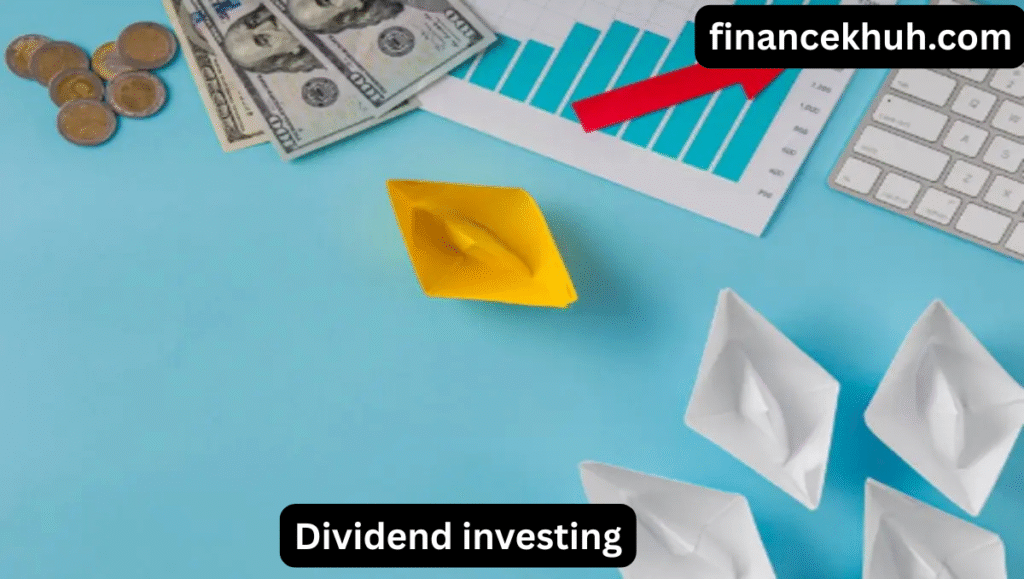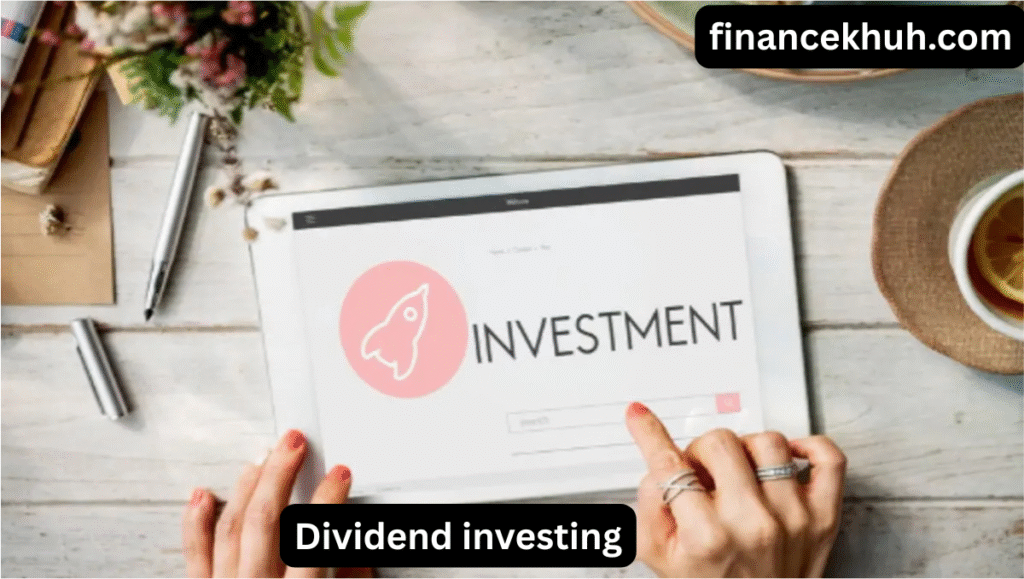Dividend investing is a strategy where you invest in stocks that regularly pay dividends—cash payouts from companies to their shareholders. This method allows you to generate passive income without needing to sell your stocks. It’s ideal for those looking to supplement their income or build wealth over time. By focusing on dividend-paying stocks, you can earn regular payouts and even benefit from the power of compounding if you reinvest those dividends.
Dividend investing is appealing because it offers financial stability, reduces volatility, and provides a steady income stream. Whether you’re new to investing or experienced, dividend stocks are a smart way to make your money work for you. This guide will help you understand how to start and succeed with dividend investing.
What is Dividend Investing?
Understanding Dividends
Let’s start with the basics. A dividend is a portion of a company’s profit that is paid out to its shareholders. These payments are usually made on a quarterly, semi-annual, or annual basis. If you own shares in a company that pays dividends, you’ll receive a portion of the company’s profits, typically in the form of cash or additional shares.
Dividend investing is a strategy where you build a portfolio of dividend-paying stocks to earn regular income. Think of it like receiving a paycheck for simply owning shares in companies you believe in. Pretty cool, right?
Why Do Companies Pay Dividends?
Companies that pay dividends are typically well-established and financially stable. These businesses have reached a point where they generate enough revenue and profit that they don’t need to reinvest all of it back into the company for growth. Instead, they share some of their profits with their shareholders.
For you as an investor, dividends are attractive because they offer a steady income stream. Unlike stocks that rely solely on price appreciation, dividend stocks can generate regular cash flow, even when the stock market is volatile.
A Simple Example
Imagine you own 100 shares of a company that pays $2 in dividends per share every year. That means every year, you get $200 in cash ($2 per share × 100 shares). That’s $200 in income without having to do anything beyond buying the stock!
The Benefits of Dividend Investing
Dividend investing isn’t just about earning passive income. It also comes with other significant advantages:
1. Steady Income Stream
As mentioned, dividend-paying stocks can provide a steady income. This can be especially helpful if you’re looking for a way to supplement your salary or even build a source of income for retirement. The best part? Dividends are often paid even during market downturns, unlike the price of stocks, which can fluctuate.
2. Compounding Returns
Reinvesting dividends can lead to compounding returns, which means your dividends earn you even more dividends. If you don’t need the income from dividends right away, you can reinvest them to buy more shares of the same company, which in turn will pay you more dividends over time. This snowball effect can significantly grow your wealth over the long term.
3. Less Volatility
Dividend-paying companies tend to be more stable than non-dividend-paying companies. Why? Because they’re typically larger, more established, and generate consistent profits. While stock prices can be volatile, dividend stocks usually provide a cushion because of the regular income they offer.
4. Tax Benefits
In some countries, dividends are taxed at a lower rate than regular income, which can provide a tax advantage if you’re looking to minimize your tax bill. (Be sure to check the specific tax rules in your country or consult a financial advisor for details.)
5. Inflation Hedge
Dividends tend to increase over time, helping to outpace inflation. While inflation erodes the purchasing power of your money, a growing dividend income stream can help offset that impact and protect your wealth in the long run.
How to Get Started with Dividend Investing
Now that we know what dividend investing is and why it’s attractive, let’s dive into the steps for getting started.
1. Know Your Goals
Before diving in, it’s important to have a clear idea of what you want to achieve with dividend investing. Are you looking for regular income, long-term growth, or a combination of both? Knowing your financial goals will help you decide how to approach dividend investing and what kinds of stocks to focus on.
2. Choose the Right Dividend Stocks
Not all dividend stocks are created equal. Some companies pay high dividends, but those dividends may not be sustainable. Others may offer lower dividends but have a solid history of increasing their payouts over time.
Here’s how you can choose the right dividend stocks:
- Dividend Yield: This is the annual dividend payment divided by the stock’s price. A higher yield sounds appealing, but don’t be fooled. A very high yield may indicate that the company is struggling or that the dividend isn’t sustainable. Look for a yield that is consistent and in line with the company’s earnings.
- Dividend Growth: Look for companies that have a history of growing their dividends over time. Companies with a long track record of increasing dividends are often more reliable.
- Payout Ratio: This is the percentage of a company’s earnings that are paid out as dividends. A payout ratio that’s too high could indicate that the company is paying out more than it can afford, which could lead to future dividend cuts. Ideally, you want a payout ratio between 40-60%.
- Financial Stability: Make sure the company is financially sound. Look for businesses with strong cash flows, low debt levels, and a track record of profitability.
- Industry: Some industries, like utilities and consumer staples, are known for paying steady dividends because they have stable cash flows. Others, like tech companies, may not pay dividends at all or offer only small dividends.

3. Diversify Your Dividend Portfolio
Just like with any investment strategy, diversification is key. Don’t put all your money into one company or sector. Instead, spread your investments across a mix of stocks from different industries to reduce risk.
For example, you could invest in:
- Dividend-paying stocks from different sectors (e.g., healthcare, energy, consumer goods).
- Dividend ETFs (exchange-traded funds), which are a basket of dividend-paying stocks from various companies.
- Dividend Aristocrats—these are companies that have increased their dividends for 25 consecutive years or more. These companies tend to be very stable.
4. Decide on a Reinvestment Strategy
You have two options when it comes to dividends:
- Take the Cash: You can have your dividends paid out to you as cash. This can be useful if you need income right away, or if you want to reinvest in other opportunities.
- Reinvest Dividends: If you don’t need the cash, you can reinvest your dividends to buy more shares of the company. This can help you build wealth over time through the power of compounding.
5. Keep an Eye on Your Investments
Once you’ve invested in dividend stocks, it’s important to stay on top of your investments. Check the company’s dividend history and financials regularly to make sure they’re still in a position to pay dividends. Also, monitor the stock price and overall market conditions to ensure you’re making smart decisions.
6. Use a Dividend Investing Platform or Broker
You can purchase dividend stocks through any brokerage account, such as:
- Robo-advisors like Betterment or Wealthfront (which may help automate the process for you).
- Traditional brokers like Vanguard, Fidelity, or Charles Schwab.
- Dividend-focused ETFs for easy access to a basket of dividend-paying stocks.
7. Monitor Your Dividend Income
One of the best parts of dividend investing is that you get to watch your income grow over time. As the companies you invest in increase their dividends or your reinvested dividends purchase more shares, you’ll see your income stream steadily rise.
Common Mistakes to Avoid in Dividend Investing
Dividend investing can be a powerful strategy, but it’s important to avoid these common mistakes:
- Chasing High Yields: As tempting as high dividend yields are, always check the sustainability of the dividend. High yields can often be a red flag.
- Not Reinvesting Dividends: Reinvesting dividends can greatly enhance your returns over time. If you take the cash instead, you’re missing out on the compounding effect.
- Lack of Diversification: Avoid putting all your money into one company or sector. This can leave you vulnerable if that company or industry faces problems.
- Ignoring Tax Implications: Dividend income is usually taxed, so be sure to consider this when calculating your returns.

Conclusion
Dividend investing is a great way to build a consistent stream of passive income, grow your wealth over time, and reduce the impact of market volatility. Whether you’re just starting out or you’re an experienced investor, dividend-paying stocks offer a unique blend of income and growth potential that can benefit investors at any stage of life.
Related post
Faq’s
1. What is dividend investing?
Dividend investing involves buying stocks that pay regular dividends, providing you with passive income. Dividends are paid from a company’s profits, typically quarterly, and can be reinvested to grow your investment.
2. How do I choose the best dividend stocks?
Look for companies with a strong financial history, consistent dividends, and a reasonable payout ratio. Stable industries like utilities and healthcare often provide reliable dividend stocks.
3. What is a dividend yield?
The dividend yield is the annual dividend payment divided by the stock price. It shows how much income you can earn from a stock, though high yields may signal risk, so check the company’s stability.
4. Can I rely on dividend income for retirement?
Yes, many people use dividend income for retirement, but it’s important to have a diversified portfolio and regularly review your stocks to ensure steady income.
5. What happens if a company cuts its dividend?
A dividend cut usually indicates financial trouble and can lower stock prices. Monitor your stocks and diversify to reduce risks from dividend cuts.
6. Is dividend investing tax-efficient?
Dividends are often taxed at a lower rate than regular income, but tax rules vary by country. Check with a tax professional to understand the specifics in your region.
